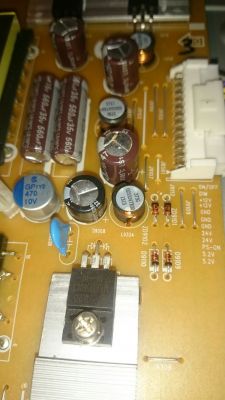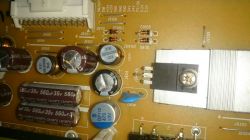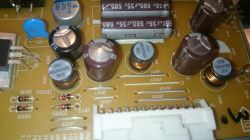FAQ
TL;DR: For a Philips 40PFL3208H/12 with no picture/sound, start with power/cap checks; "It should preferably be at 105 °C." Use 105°C-rated capacitors and higher-voltage replacements when needed. [Elektroda, Krzysztof Druś, post #17104359]
Why it matters: This helps DIYers quickly decide if a simple capacitor swap and basic measurements can revive the set or if service is smarter.
Quick Facts
- Model in thread: Philips 40PFL3208H/12 SMART (aka 3208H/12). [Elektroda, Pedros050, post #17094077]
- Reported outcome: second bad capacitor found; software reinstalled; repair cost PLN 140. [Elektroda, LukayLukay, post #17224673]
- Replacement guidance: Prefer 105°C-rated caps; higher voltage rating (e.g., 50V) is fine if it fits. [Elektroda, Krzysztof Druś, post #17104359]
- First suspect part noted: 470uF/16V electrolytic on PSU. [Elektroda, Krzysztof Druś, post #17096230]
- Measure PSU and backlight rails before swapping parts. [Elektroda, Pedros050, post #17094077]
Did the matrix/panel fail if there’s no picture and no sound, but the TV responds to the remote?
Unlikely in this case. The final fix found another bad capacitor and required a software reinstall. The panel was not replaced. If the matrix failed, sound usually remains. Here, two capacitors were bad and firmware was reloaded, restoring function for PLN 140. [Elektroda, LukayLukay, post #17224673]
What’s the first diagnostic step on a Philips 40PFL3208H/12 with these symptoms?
Measure the power supply and backlight voltages with a multimeter before replacing parts. Confirm standby and main rails at the PSU connector. This quickly separates a PSU/backlight issue from mainboard or software causes. Keep notes of each rail versus its label. "Measure power supply voltage and on the backlight" was the first ask in the thread. [Elektroda, Pedros050, post #17094077]
Which capacitor should I replace first?
Start with the visibly failed one, then the commonly flagged part: 470uF/16V on the PSU. Check for bulging tops or leakage. Replace like-for-like capacitance and equal or higher voltage. Use a quality low-ESR, 105°C part. As one expert said, "Exchange 470uF / 16v." Verify polarity before soldering. [Elektroda, Krzysztof Druś, post #17096230]
Is a 470uF/50V capacitor safe to use instead of 16V?
Yes, a higher voltage rating is acceptable if physical size fits and ESR is suitable. Prioritize a 105°C temperature rating for reliability. The advisor clarified that extra voltage headroom does not harm operation. Quote: "It should preferably be at 105 °C." Ensure correct polarity and secure soldering. [Elektroda, Krzysztof Druś, post #17104359]
How do I identify bad capacitors on the PSU board?
Look for domed tops, split vents, or brown residue from electrolyte. Any leakage or swelling means replacement. These failures are common in monitor and TV power sections. Replace suspect parts as a set if several show age. Confirm polarity marks before removal. "They are recognized ... by a bulge on top and electrolyte blots." [Elektroda, Anonymous, post #17095902]
I replaced the bulged cap and nothing changed—what next?
Measure all PSU and backlight rails. A second capacitor may be faulty even if it looks fine. In this case, two capacitors were bad and firmware had to be reinstalled to recover. Record voltages versus the connector label. If rails are unstable, recap the affected section. [Elektroda, LukayLukay, post #17224673]
What did the successful repair involve and how much did it cost?
Service found another failed capacitor and reinstalled the TV software. The total reported cost was PLN 140. The set returned to normal operation. This path avoids unnecessary panel replacement. Keep this cost as a benchmark for similar faults. [Elektroda, LukayLukay, post #17224673]
Why does capacitor polarity matter so much when soldering?
Electrolytics are polarized. Reverse installation can destroy the capacitor and risk board damage. One expert cautioned that mixing plus and minus means "the capacitor will fire?" Always match the board’s plus/minus markings and the capacitor stripe. Double-check before powering up. [Elektroda, Krzysztof Druś, post #17105366]
When should I hand it to a repair shop?
If you lack a meter, skills, or see confusing readings, stop and refer it to an RTV repair point. As advised: "Refer RTV repair point and locate fault and power supply will be repaired." This avoids further damage and speeds diagnosis. [Elektroda, Pedros050, post #17105378]
Is a connector label mismatch (12 vs 13 pins) a problem?
It can indicate a revision or silkscreen mismatch. Verify the actual pin count and the voltage legend before probing. An expert noted a 13-pin socket with a 12-pin description. Trust the board’s measured pins and markings near your connector. Confirm ground reference before measuring. [Elektroda, Krzysztof Druś, post #17105366]
Can software cause these symptoms on this Philips model?
Yes. In the documented case, the TV had to be "unloaded" and the software installed again after hardware repair. Firmware issues can present as no audio/video while the set still responds to the remote and network. Reflashing restored normal behavior here. [Elektroda, LukayLukay, post #17224673]
How do I measure the backlight and PSU rails safely?
Three-step check:
- Set DMM to DC volts and reference chassis ground.
- Measure standby and main rails at the PSU connector against its label.
- Measure the backlight supply when powering on.
This targets the failure zone before swapping parts. Document readings. [Elektroda, Pedros050, post #17094077]
What should I do after a capacitor leaked onto the board?
Clean the affected area thoroughly and let it dry before power-up. Residue can conduct or corrode traces. As one member reminded, "Do not forget to wash the tile." Use appropriate electronics-safe cleaning methods and inspect pads before reinstalling parts. [Elektroda, Freddy, post #17104531]





